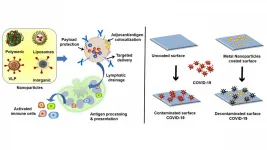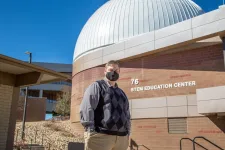INFORMATION:
Scientists suggested using non-symmetrical magnets for target drug delivery
2021-02-09
(Press-News.org) To achieve target delivery of drugs to cells and organs, scientists have to be able to transport the molecules of pharmaceutical substances to targets using a controllable carrier. The role of such a carrier can be played by special particles, such as lipid droplets or magnetic nanoparticles. Among the latter, the most popular are the ones based on iron oxides. Their sizes range from 1 to 100 nm, which is dozens of times smaller than animal cells, and they can be moved within a body using an external magnetic field.
However, in practice, it is quite difficult to control nanoparticles with magnets, as the magnetic field quickly becomes weaker when the distance from the magnet increases. This problem is usually solved by superconducting magnets with very high magnetic field intensity. However, they are extremely expensive and difficult to work with. A team of scientists from Immanuel Kant Baltic Federal University (Kaliningrad) and the University of Genoa (Italy) suggested a new approach to regular permanent magnets.
"To control magnetic nanoparticles, modern-day scientists often use either individual magnets or the so-called Halbach systems: classic magnet arrays that have a magnetic field only on one side. When choosing a magnet or a system, people usually pay attention only to magnetic field induction, not to its driving force. However, it's the driving force that determines the efficiency and speed of nanoparticle delivery. Our colleagues tasked us with developing more efficient magnets to secure the delivery of nanoparticles with drugs to target organs in lab mice. The magnets had to be very small, so we were limited in the weight and size of our materials. Still, we managed to achieve improved efficiency using an array of different magnets," said Alexander Omelyanchik, a co-author of the work, and a postgraduate student at the Laboratory of Nevel Magnetic Materials, IKBFU.
Instead of a single cylindrical magnet, the scientists suggested using a combination of permanent magnets with different shapes. To confirm the efficiency of this solution, the team used cylindrical and cubic neodymium magnets to build various symmetrical and non-symmetrical assemblies. The total surface area of magnets or their arrays did not exceed 2 cm2. After that, the team measured the values of the magnetic field and its gradient at 4 mm under the surface of the magnet. Approximately the same distance separates the surface of a mouse's skin and its internal organs. From all magnet combinations, the team chose the ones with the strongest magnetic driving force (a physical value that is proportional to the product of magnetic field induction and its gradient).
The strongest magnetic force at a given point was registered for a combination of four magnets with the same polarity, of which two were cubic and the other two consisted of three smaller cylindrical magnets each. However, a different method of measurement showed different results. The strongest magnetic force for the area of 1 cm2 was produced by a magnet with the same structure but different polarity of one of the cylindrical components. The magnetic force of such non-symmetrical combinations in a 1 cm2 area (the size of a liver or heart or a lab mouse) was almost ten times stronger than that of regular cylindrical magnets. The team believes that the new approach could potentially apply to humans too.
"We have been studying magnetic nanoparticles in close collaboration with our colleagues from Italy, Czech Republic, Spain, Sweden, and other European countries for quite some time now. Although we are physicists, we are in constant communication with chemists, biologists, and specialists in material studies. This complementary experience helps us develop unique solutions. The interdisciplinary nature of this topic is very appealing to me, as this field of study still has many unanswered questions," commented Alexander Omelyanchik.
ELSE PRESS RELEASES FROM THIS DATE:
Porous materials unfavorable for coronavirus survival
2021-02-09
WASHINGTON, February 9, 2021 -- As COVID-19 spreads via respiratory droplets, researchers have become increasingly interested in the drying of droplets on impermeable and porous surfaces. Surfaces that accelerate evaporation can decelerate the spread of the COVID-19 virus.
In Physics of Fluids, by AIP Publishing, researchers from IIT Bombay show a droplet remains liquid for a much shorter time on a porous surface, making it less favorable to survival of the virus.
The researchers found the coronavirus can survive for four days on glass, seven days on plastic, and seven days on stainless steel. But on paper and cloth, the virus survived for only three hours and two days, respectively.
"Based on our study, we recommend that furniture in hospitals and offices, ...
SARS-CoV-2 infection among migrant workers in Singapore
2021-02-09
What The Study Did: Researchers examined how common SARS- CoV-2 infection was among migrant workers in Singapore.
Authors: Vernon J. Lee, M.B.B.S., Ph.D., of the Ministry of Health in Singapore, is the corresponding author.
To access the embargoed study: Visit our For The Media website at this link https://media.jamanetwork.com/
(doi:10.1001/jama.2020.24071)
Editor's Note: The article includes conflict of interest and funding/support disclosures. Please see the article for additional information, including other authors, author contributions and affiliations, conflict of interest and financial disclosures, and funding and support.
INFORMATION:
Media advisory: The full article is linked to this news release.
Embed ...
Advanced simulations reveal how air conditioning spreads COVID-19 aerosols
2021-02-09
WASHINGTON, February 9, 2021 -- The detailed physical processes and pathways involved in the transmission of COVID-19 are still not well understood. Researchers decided to use advanced computational fluid dynamics tools on supercomputers to deepen understanding of transmission and provide a quantitative assessment of how different environmental factors influence transmission pathways and airborne infection risk.
A restaurant outbreak in China was widely reported as strong evidence of airflow-induced transmission of COVID-19. But it lacked a detailed investigation about exactly how transmission occurred.
Why did some people get infected while others within the same area did not? ...
COVID-19 pandemic as opportunity to ensure more successful future for science, public health
2021-02-09
What The Viewpoint Says: The missteps and miscommunications that have stymied a more effective U.S. and global response to the COVID-19 pandemic bring into sharp focus the deficiencies in governance systems of the U.S. public health and scientific institutions.
Authors: K. M. Venkat Narayan, M.D., M.Sc., of the Rollins School of Public Health and School of Medicine at Emory University in Atlanta, is the corresponding author.
To access the embargoed study: Visit our For The Media website at this link https://media.jamanetwork.com/
(doi:10.1001/jama.2020.23479)
Editor's Note: The article includes conflict of interest disclosures. Please see the article for additional information, including other authors, author contributions and affiliations, conflict of interest ...
School closures may not reduce coronavirus deaths as much as expected
2021-02-09
WASHINGTON, February 9, 2021 -- School closures, the loss of public spaces, and having to work remotely due to the coronavirus pandemic have caused major disruptions in people's social lives all over the world.
Researchers from City University of Hong Kong, the Chinese Academy of Sciences, and Rensselaer Polytechnic Institute suggest a reduction in fatal coronavirus cases can be achieved without the need for so much social disruption. They discuss the impacts of the closures of various types of facilities in the journal Chaos, from AIP Publishing.
After running thousands of simulations of the pandemic response in New York City with variations in social distancing behavior at home, in schools, at public facilities, and in the workplace ...
Disparities in SARS-CoV-2 testing in Massachusetts during COVID-19 pandemic
2021-02-09
What The Study Did: To mitigate subsequent waves of COVID-19, allocating testing resources to locations of greatest need is important. Researchers in this study examined the alignment of testing to epidemic intensity in Massachusetts.
Authors: Scott Dryden-Peterson, M.D., M.Sc., of Brigham and Women's Hospital in Boston, is the corresponding author.
To access the embargoed study: Visit our For The Media website at this link https://media.jamanetwork.com/
(doi:10.1001/jamanetworkopen.2020.37067)
Editor's Note: The article includes conflict of interest and funding/support disclosures. Please see the article for additional information, including other authors, author contributions and affiliations, ...
Biomaterials could mean better vaccines, virus-fighting surfaces
2021-02-09
WASHINGTON, February 9, 2021 -- Advances in the fields of biomaterials and nanotechnology could lead to big breakthroughs in the fight against dangerous viruses like the novel coronavirus that causes COVID-19.
In APL Bioengineering, by AIP Publishing, researchers from the Indian Institute of Science describe two possibilities being explored by scientists in the field to make vaccines more effective and build surfaces that could fight and kill viruses on their own.
"It is important not just in terms of COVID," said author Kaushik Chatterjee. "We've seen SARS, ...
Regular walnut consumption may reduce negative outcomes of H. pylori infection
2021-02-09
FOLSOM, Calif., February 9, 2021 - A new animal study, published in the Journal of Clinical Biochemistry and Nutrition, suggests regular walnut consumption may be a promising intervention for reducing negative outcomes associated with Helicobacter pylori (H. pylori) infection, a widespread bacterial infection that affects more than half of the world's population.
Using mice models, researchers from the CHA Cancer Prevention Research Center in Korea found preliminary evidence that eating a diet rich in walnuts may help protect against negative outcomes associated with H. pylori infection. Specifically, the research found that walnut extracts, formed from ...
Embry-Riddle alumna helps unravel key mysteries of rare stars
2021-02-09
Within the constellation Cygnus, an elderly star and its massive companion are having one last hurrah, flinging off mass at an incredible rate before they explode as supernovae and collapse into a black hole.
Now, researchers including recent Embry-Riddle Aeronautical University graduate Laura M. Lee have mapped the elderly star's orbit around its oversized and equally ancient partner. In a scientific first, they have also determined the dynamical mass of both stars that make up a binary system called Wolf-Rayet 133.
The team's findings, published Feb. 9, 2021 by Astrophysical Journal ...
Bats & pangolins in Southeast Asia harbour SARS-CoV-2-related coronaviruses, reveals new study
2021-02-09
While the World Health Organization (WHO) continues its mission to Wuhan investigating the origin and early transmission of SARS-CoV-2, a new study led by scientists from Duke-NUS Medical School, Singapore, and Chulalongkorn University, Thailand, shows that SARS-CoV-2-related coronaviruses (SC2r-CoVs) are circulating in animals as far away as Thailand. The study, published in Nature Communications today, reported that high levels of neutralising antibodies against the virus were present in both bats and pangolins found in the Southeast Asian country. The study further indicates that more SC2r-CoVs are likely to be discovered ...




